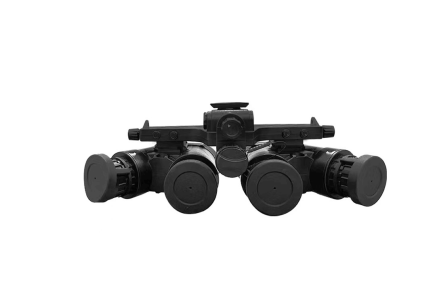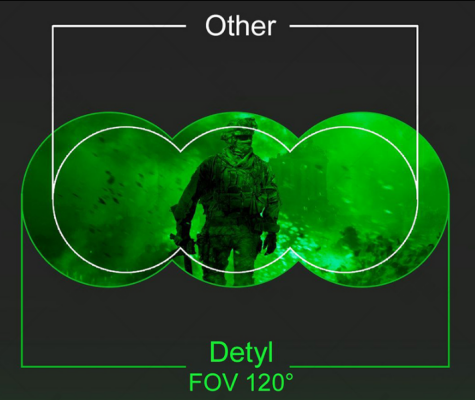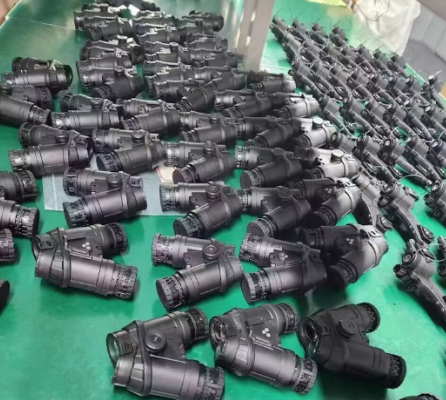ONICK has developed a ground-based panoramic night vision device called NVG-JY, with the goal of providing the operator with more information under the goggles, allowing him to pass the OODA loop (Observe, Orient, Decide, Act) faster. The most notable feature of NVG-JY is the presence of four independent image intensification tubes with four independent objective lenses arranged in a panoramic direction. The two center lenses point forward like traditional double-tube goggles, giving the operator more depth perception, while the other two lenses point slightly outward from the center to increase peripheral vision. The two tubes on the right and the two tubes on the left are spliced at the eyepiece. The operator sees the two center tubes with some overlap with the two outer tubes, resulting in an unprecedented 120° FOV. This is definitely a game changer for the SOF community. The two right tubes and the two left tubes are mounted in a merged assembly and suspended from a bridge, providing the operator with the option of interpupillary adjustment. They can also be easily removed and operated as independent handheld viewers. The IPD of both systems can be adjusted on the helmet mount.
The military application of night vision technology can be traced back to the late World War II. In order to meet the needs of the war, Germany successfully developed active infrared night vision goggles in 1944, which provided convenience for night combat. Due to the defeat of the German army, a large number of infrared night vision equipment were seized by the Soviet Union, and the United States obtained most of the research data. Later, the US military successfully developed active infrared night vision goggles and used them in the Korean War and the Vietnam War. Due to the shortcomings of high energy consumption, easy exposure, and small number of equipment, they were gradually eliminated by the US military. In order to make up for the defects of active infrared night vision goggles, in 1962, Americans successfully developed image intensifiers, which made a leap in the development of night vision equipment. During the Vietnam War, the United States used cascade image enhancement technology for actual combat applications and successfully developed the first generation of low-light night vision goggles. Following infrared night vision goggles and low-light night vision goggles, a thermal imager that uses the target's own infrared radiation for observation was also successfully developed and put into use. In the 1980s, the US military regarded night vision equipment as a high-tech weapon, and the total investment in the development of night vision equipment in 10 years was as high as 7 to 8 billion US dollars.
What is the charm of night vision equipment that makes the United States spend huge amounts of money on research and development? Due to the particularity of night vision technology, combat troops can break through the obstacles of the night and gain the freedom of night battles. After installing night vision equipment on tanks, ships, aircraft and other equipment, the effective combat time is greatly extended. During the air strike phase of the Gulf War, most of the attacks were launched at night. During the ground combat phase, multinational forces also relied on the advantages of night vision equipment to frequently launch attacks at night. The combination of night vision technology and weapons and equipment will further improve the effectiveness of weapons and equipment in obtaining information, carrying out strikes and coordinated operations at night and in bad weather conditions.
At present, the US military is in a world-leading position in the field of night vision equipment. In addition to the four-eye night vision device, the US military has also developed a third-generation enhanced night vision device. The night vision device relies on wireless data transmission technology, allowing US soldiers to shoot directly at the target behind them without looking back. In addition, the US military's Color Path night vision color night vision device makes soldiers fight at night as if it were daytime, and the clarity is so high that even the camouflage patterns on the clothes can be vaguely discerned. The "Alpha-1962" night vision aiming system developed by Russia can help soldiers solve a series of problems they may encounter when performing night sniping missions in the wild. The British-designed monocular night vision goggles connected to the helmet allow the user to "see all directions" and find enemies hiding in blind spots without having to look out or turn their heads.





